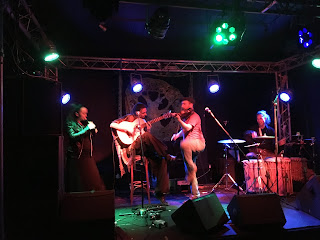PerKelt
Wagon and Horses, Digbeth, Birmingham
Tuesday 12 March
A friendly Victorian pub in
Birmingham seemed a slightly incongruous setting for PerKelt, who are more
often to be found at medieval festivals and midwinter fairs. The band has been
peddling its unique brand of pagan speed folk since 2008 (and they've featured twice before on this blog.) Founder members Stepan
Honc (guitar, vocals) and Paya
Lehane (vocals, recorders, harp) - both
from the Czech Republic - with their French drummer David Maurette have
recently become a quartet thanks to the addition of Scottish fiddler Duncan
Menzies. The latter's contribution underlines the joyful Celtic aspects of
their music but there is still plenty of dark medievalism in PerKelt's sound.
Supported by singer-guitarist
Jay Fraser and bluegrass-inflected duo Copper Viper, this was the first date in
a short tour by PerKelt prior to the release of a forthcoming album. We were
treated to some intriguing new songs alongside more familiar PerKelt material:
their distinctive take on songs from Shakespeare, their outstanding arrangement
of the early-Renaissance 'Tourdion' and their stirring versions of Swedish folk
ballad 'Herr Mannelig' and 13th century Occitan bourrée 'Ai Vist Lo Lop'.
Paya's voice and
recorder-playing were as powerful and eerie as ever, but strangely there was no
sign of her harp. Perhaps the band felt that this was superfluous given the
combined strings of Stepan's guitar and Duncan's fiddle.
I suspect the good people of
Birmingham were not quite sure what to make of PerKelt's unlikely tales of Swedish
trolls, but how could anyone resist the sincerity, good humour, virtuosity and
exuberance of these four extraordinary musicians?





